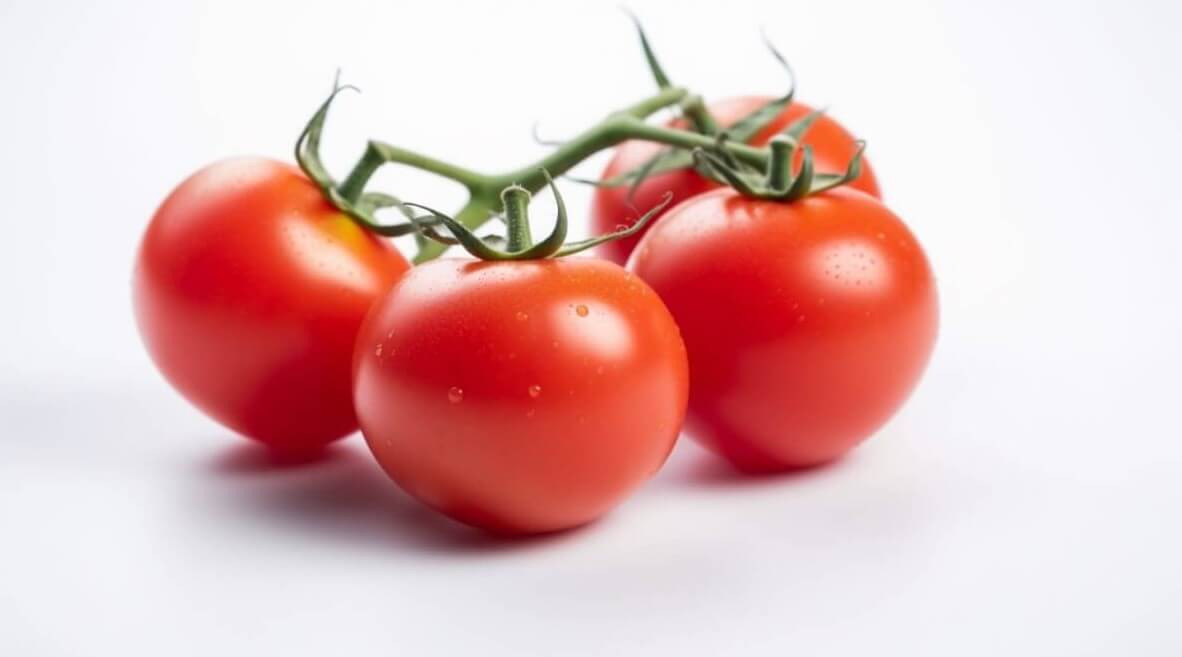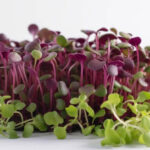Would you prefer to listen to a short podcast discussion about this article? Click on the audio below.
Tomatoes are one of the most popular crops grown in the UK and for good reason. They are tasty, nutritious, and versatile, making them a staple ingredient in a wide variety of dishes. Whether you are new to tomato growing or a seasoned pro, there are a few key things to keep in mind when cultivating these delicious fruits.
In this article, we will explore how to grow tomatoes in greenhouses and outside, covering everything from choosing the right tomato variety for the UK climate to proper watering, fertilizing, and pruning practices to common pests and diseases to watch out for. So whether you are a seasoned grower or just getting started, read on for some great tips on growing tomatoes.
Table of Contents

1. Choosing the Right Tomato Variety for the UK Climate
The UK climate can be quite challenging when it comes to growing tomatoes. However, with the right tomato variety, you can still enjoy fresh, juicy tomatoes right from your garden.
Understanding the Different Tomato Varieties Available
Several tomato varieties are available, ranging from cherry tomatoes to beefsteak varieties. Some of the most popular varieties include Gardeners Delight, Sungold, and Moneymaker.
Factors to Consider When Choosing a Tomato Variety
When choosing a tomato variety for the UK climate, it's important to consider factors such as disease resistance, yield, and taste. Look for varieties that are resistant to common diseases such as blight. Additionally, consider the length of the growing season and choose varieties that mature quickly, especially if you're growing tomatoes outdoors.
2. Preparing the Soil for Successful Tomato Growth
Preparing the soil is crucial for successful tomato growth. Here's what you need to do to ensure your tomatoes thrive:
Testing Your Soil for Optimal Tomato Growth
Before planting your tomatoes, it's important to test your soil to determine its pH level and nutrient content. You can purchase a soil testing kit online or at a garden centre.
Amending Your Soil for Improved Tomato Growth
Once you know your soil's pH level and nutrient content, you can amend it to ensure optimal tomato growth. Tomatoes prefer slightly acidic soil with a pH of around 6.0-6.8. Adding organic matter such as compost or well-rotted manure can help improve soil structure and fertility.
3. Understanding the Best Planting Techniques for Greenhouse and Outdoor Growing
Proper planting techniques are important whether you're growing tomatoes in a greenhouse or outdoors. Here's what you need to know:
Preparing Your Greenhouse for Optimal Tomato Growth
If you're growing tomatoes in a greenhouse, ensure it's well-ventilated to prevent disease. You can also add shading to prevent the greenhouse from overheating during summer.
Preparing Your Soil for Outdoor Tomato Growing
Choose a spot with well-draining soil and plenty of sunlight when growing tomatoes outdoors. Avoid planting tomatoes in areas where tomatoes, potatoes, or peppers have been grown in the past, as these crops can harbour pests and diseases that can affect tomato plants.
When to Plant Tomatoes
The best time to plant tomatoes in the UK is from mid-April to mid-May, depending on the weather. If you're growing tomatoes in a greenhouse, you can start planting earlier, around mid-March.
4. Proper Watering, Fertilizing, and Pruning Practices
Proper care and maintenance are important for maximizing the yield and flavour of your tomato plants. Here's what you need to know:
Understanding the Watering Needs of Tomatoes
Tomato plants need consistent moisture to thrive, but overwatering can lead to root rot. Water your plants deeply once or twice a week, depending on the weather.
Choosing the Right Fertilizer for Your Tomato Plants
Tomatoes are heavy feeders and require regular fertilization. Choose a balanced fertilizer with a higher potassium content to promote fruit development.
Pruning Your Tomato Plants for Maximum Yield
Pruning tomato plants can promote airflow, prevent disease, and increase fruit yield. Remove suckers (small shoots that grow in the crotch between the stem and a branch) and any leaves that are touching the soil to prevent fungal disease.
5. Managing Common Tomato Pests and Diseases
Growing tomatoes can pose some challenges when it comes to pests and diseases. Here are some common tomato pests:
Identifying Common Tomato Pests
- Whitefly: These small white insects suck sap from tomato plants, leaving behind sticky honeydew.
- Aphids: These small insects also suck the sap out of the plant, causing yellow and distorted leaves.
- Red Spider Mites: These tiny mites create webs on the plant and suck sap from the leaves.
To prevent these pests, use insecticidal soap or neem oil and keep your greenhouse or garden tidy.

Preventing and Treating Tomato Diseases
Common diseases that affect tomatoes include blight and tomato mosaic virus. To prevent blight, keep leaves dry and remove infected foliage. To prevent tomato mosaic virus, buy certified disease-free seeds and avoid smoking near your plants.
If your plants do get infected, remove and destroy the affected leaves or plants to prevent the spread of disease.
6. Harvesting and Storing Your Crop for Maximum Flavour and Shelf Life
Knowing When Your Tomatoes Are Ready to Harvest
Tomatoes are ready to harvest when they are fully coloured and firm to the touch. Give them a gentle tug; they are ready if they come off the vine easily.
Storing for Maximum Flavor and Shelf Life
Store your tomatoes at room temperature, out of direct sunlight. Placing them in a paper bag can also help them ripen faster. Do not store them in the fridge, as this can affect their flavour and texture.
7. Top Tips for a Bountiful Tomato Crop
Providing Optimal Growing Conditions for Your Tomato Plants
Tomatoes need plenty of sunshine and well-draining soil. In a greenhouse, ensure the temperature is between 18°C to 27°C. Water regularly and feed with tomato fertilizer every two weeks.
Maximizing Your Tomato Yield in the UK
Encourage pollination by gently shaking the plant or introducing bumblebees into the greenhouse to maximise your yield. Prune your plants to encourage growth.
8. Troubleshooting and Overcoming Common Tomato Growing Challenges
Identifying and Addressing Common Tomato Growing Challenges
Common tomato growing challenges in the UK include overwatering, underwatering, and lack of sunlight. Address these by ensuring proper watering practices and placing your plants in sunnier spots.
Troubleshooting Tomato Growing Problems
Check for pests, diseases, or nutrient deficiencies if your tomato plants are not growing. Adjust the growing conditions and address any issues promptly. You can enjoy a bountiful and delicious crop by following these tips for growing tomatoes. Remember to choose the right tomato variety for the UK climate, properly prepare your soil and growing area, and give your plants the right amount of water, nutrients, and care throughout the growing season.
With a little effort and attention, you can enjoy homegrown tomatoes that are bursting with flavour and nutrition. Happy planting!
FAQ
1. When is the best time to plant tomatoes?
While the exact timing may vary depending on your specific location and growing conditions, the general rule of thumb is to plant tomato seeds indoors in February or March and to transplant them outdoors in late May or early June, when all risk of frost has passed.
2. What common pests and diseases can affect tomato plants?
Tomato plants in the UK may be susceptible to a range of pests and diseases, including aphids, whiteflies, spider mites, tomato hornworms, blight, and blossom end rot. To prevent and treat these problems, it is important to keep your plants healthy and well-cared for and to take prompt action if you notice any signs of damage or disease.
3. What is the best way to store fresh tomatoes?
To get the most flavour and shelf life out of your homegrown tomatoes, store them at room temperature in a single layer, away from direct sunlight. Do not refrigerate tomatoes, as this can cause them to lose flavour and texture. If you have an excess of ripe tomatoes, consider canning or freezing them for later use.
4. Do I need a greenhouse to grow tomatoes?
While a greenhouse can be a great option for growing tomatoes, it is not strictly necessary. Many tomato varieties can be grown outdoors in the UK climate, as long as you choose the right variety and provide them with proper care and attention. If you choose to grow them outdoors, plant them in a sunny, sheltered spot with well-draining soil.
Need help with this article? Contact Us, and we will be happy to assist you.
Here is an excellent explanation from Love The Garden
If you are keen on organic gardening, check out The Soil Association website
If you need any further information or assistance with this article, don't hesitate to Contact Us




















